7 Notable New Restaurants in Hawai‘i
These spots opened in a landscape altered by the pandemic—and remind us of the joy of dining out, whether it’s a jovial omakase counter or regional Peruvian food served from a truck.
These spots opened in a landscape altered by the pandemic—and remind us of the joy of dining out, whether it’s a jovial omakase counter or regional Peruvian food served from a truck.
By Maria Burke, Martha Cheng, Thomas Obungen and Mari Taketa | Photography by Olivier Koning, Laura La Monaca and Aaron K. Yoshino
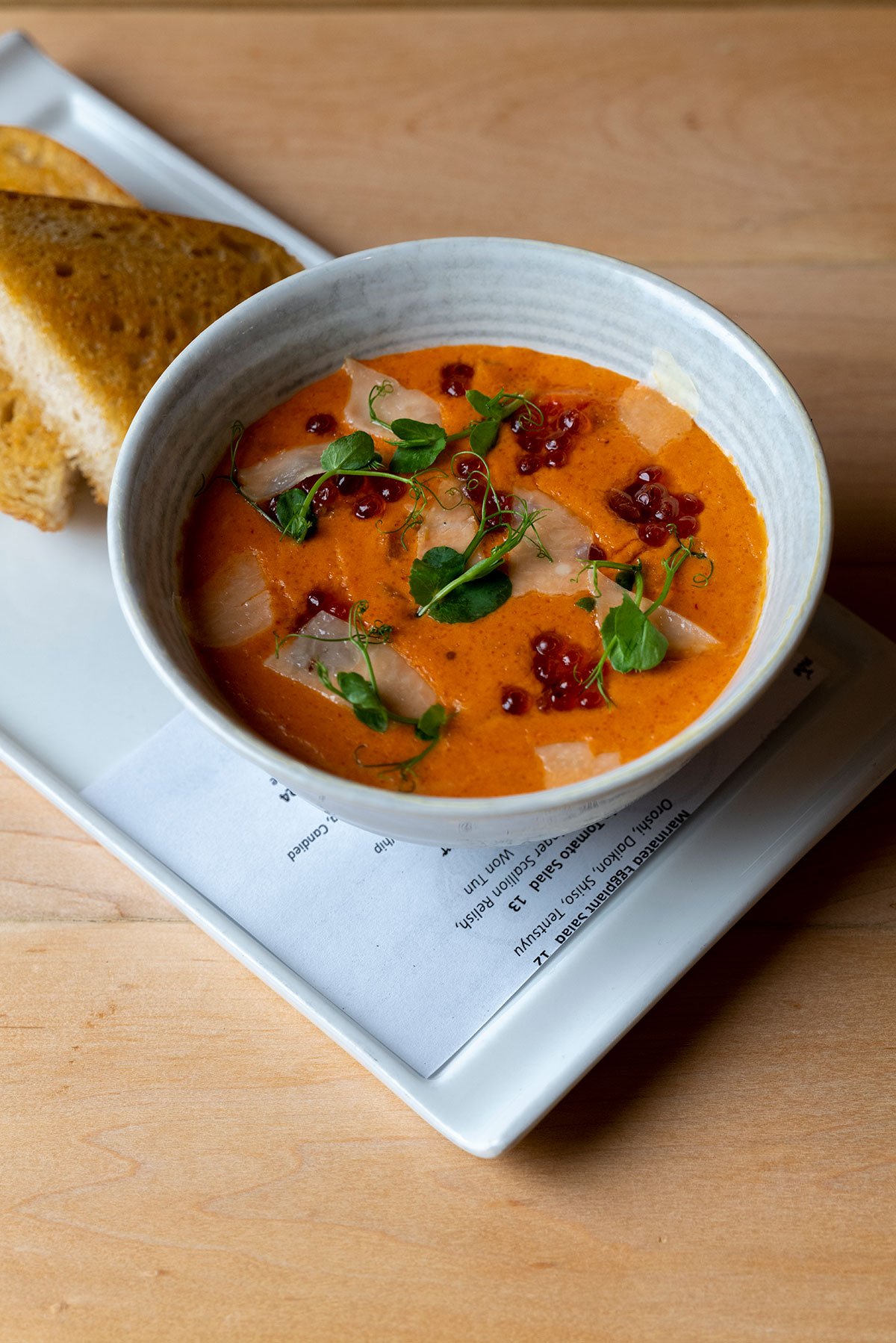
… for dinner—small plates of abalone Rockefeller, and cold-smoked tomatoes flooded with ume ponzu. It’s as if Jason Peel, after decades of running restaurants for other chefs, couldn’t hold it all in anymore and just let loose in his first place of his own. Let’s say our excitement matches his.
Brunch is Nami Kaze at its best, more casual and drawing on some of the best breakfast traditions from across cultures, like the played-straight Japanese breakfast or labneh toast. But more often, cultures collide, as with the eggs Benedict, which swaps out listless English muffins for crisp Hong Kong-style shrimp toasts, cut into finger-sandwich lengths to be dipped into the poached eggs and hollandaise. And soon, you learn that Peel’s menu is not at all what you’d expect. The so-called omelets are silky-smooth chawanmushi topped with anything from mapo tofu to mentaiko cream, the latter’s richness offset with ikura. And then that honey walnut shrimp waffle: It’s the best thing to happen to waffles since fried chicken.
Though it seemed that Peel, born and bred on Kaua‘i, would have been content being the right-hand man to chefs for many more years, when the pandemic hit, it distilled his priorities. As Hawai‘i turned inward, Peel turned to Hawai‘i—to the chefs and cooks who worked for him, to the farmers he worked with—and wanted to build a home that didn’t yet exist. That meant creating a more nurturing environment than the work culture of many kitchens and focusing on seafood and vegetables.
The latter is more evident at dinner, where you’ll find wasabi okra and shishito peppers with preserved calamansi and black sesame. Corn beignets are puffs of air brought down to earth with a dredging of Japanese curry salt and Kewpie mayo. And there are two dishes of ‘ulu, one of which is ‘ulu tots (again, misdirection!) made with ‘ulu flour and fried, and though they’re paired with his grandfather’s recipe for barbecue sauce, the effect is surprisingly Italian, like fried polenta in tomato sauce. Like a lot of Peel’s food, it is our local culture returning to us by way of another.
While the vegetables are local, the seafood combines the local and imported. The local: Kona abalone dressed up oysters Rockefeller style, doused in butter and topped with garlicky kale and Sweet Land Farm’s goat cheese tomme. The imported: hamachi crudo with ají amarillo and fried ogo. Recently, Peel became one of the first chefs to buy fish from Paepae O He‘eia’s restored Hawaiian fishpond, which has yielded barracuda, toau (blacktail snapper) and Aussie mullet, which he has fried and served whole. Sometimes, though, like with pāpio, there isn’t enough for dinner service, so he fries it up for the cooks. But it’s all part of Nami Kaze as a teaching kitchen—Peel was a Kapi‘olani Community College culinary instructor for six years. And maybe one day, those fish will find a place in future omakase dinners alongside the à la carte menu. Because yes, there’s more to come. So much more. –MC
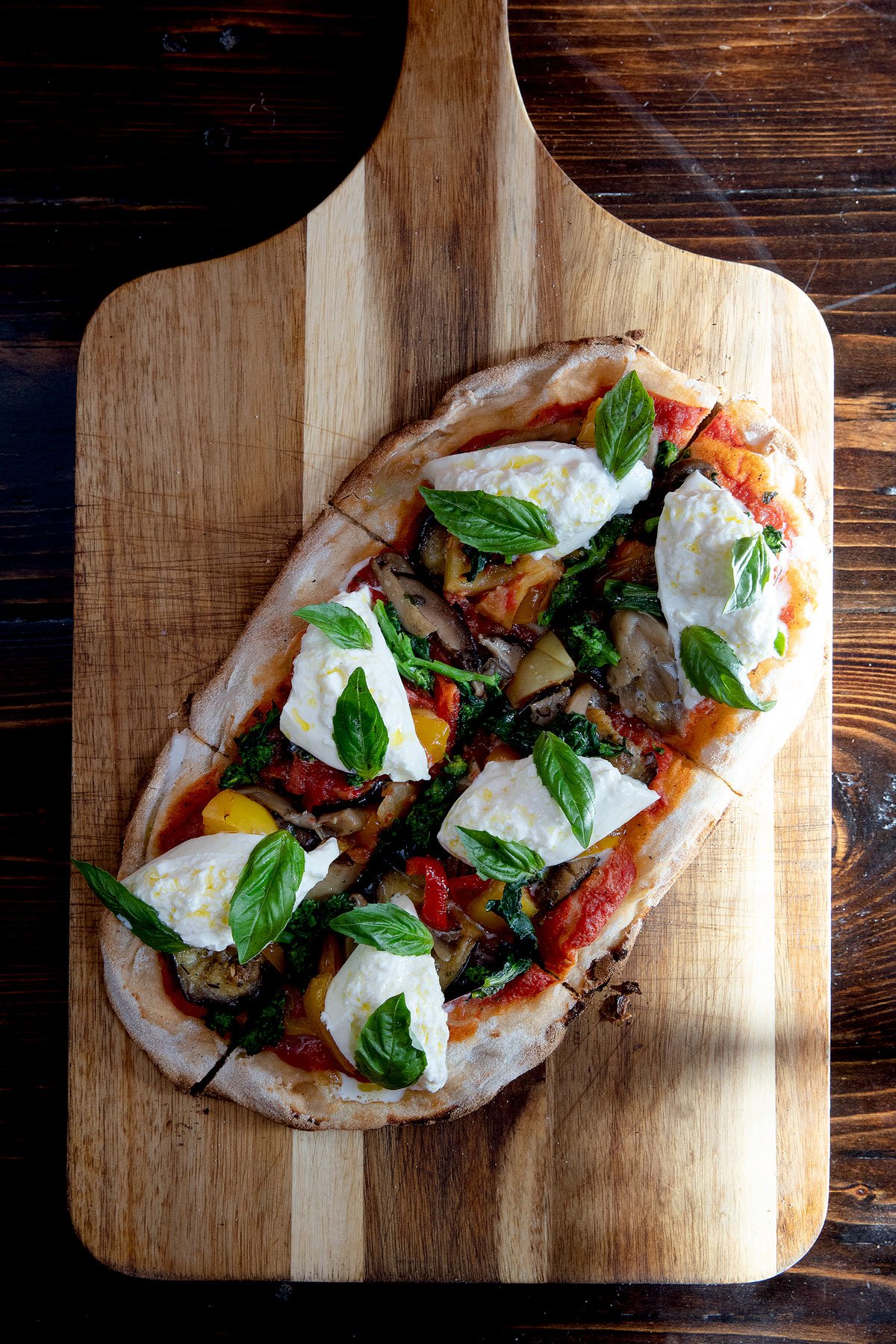
An almost 10,000-square-foot warehouse on Kawaiaha‘o Street hides Hawai‘i’s first mozzarella factory and a wonderland of Italian delights. On the shelves are specialty imports including …
… colatura di alici, an Italian fish sauce from the Campania region, and single-barrel Giuseppe Giusti balsamic vinegars, which have been around since 1605. In the deli case: truffle mortadella and capocollo. But the real draws are the made-to-order Roman-style pizzas and rustic, yet elevated, sandwiches. The most popular sandwich so far? The Bolognese, featuring thinly sliced mortadella dotted with pockets of fat, draped over schiacciata—a light and fluffy cousin of focaccia—and smeared with pistachio crema. It’s topped with stracciatella (hand-pulled shreds of mozzarella soaked in heavy cream) and more chopped pistachios. It’s heavenly.
Honolulu has its share of Italian restaurants, but Bocconcino, which references the small balls of mozzarella but also any tasty nibble or snack, is different. Take the ’nduja pizza, which combines spicy, spreadable salami with Corbarino tomatoes (an ancient variety), cured red onion, more stracciatella and fresh basil on a hand-formed crust coated with a thin layer of semolina flour, giving it an addictive crunch. The tomato is bittersweet, yet bold enough to support the intense ’nduja.
Owner Donato Loperfido wanted to make fresh mozzarella on O‘ahu many years ago. He was born and raised in Alberobello, Puglia, in southern Italy, where he watched his grandmother make varieties of fresh cheese at home. He spent decades cooking Italian food in kitchens around Honolulu and making his own mozzarella in-house. He wanted to make more mozzarella, but “Hawai‘i was not ready.” Now it is, he says. In 2005, he started Flavors of Italy, an import business, and in 2021, with Hawai‘i obsessed with specialty goods, he began the mozzarella factory. Head cheesemaker Simone Orlandini spends an average of eight hours a day making five kinds of mozzarella: burrata, bocconcini, stracciatella, fior di latte and zizzona—the last a one-pound bulb of pure mozzarella. The cheese, like most of what you’ll taste at Bocconcino, is comforting, delicious and supremely decadent in its simplicity.
—Maria Burke
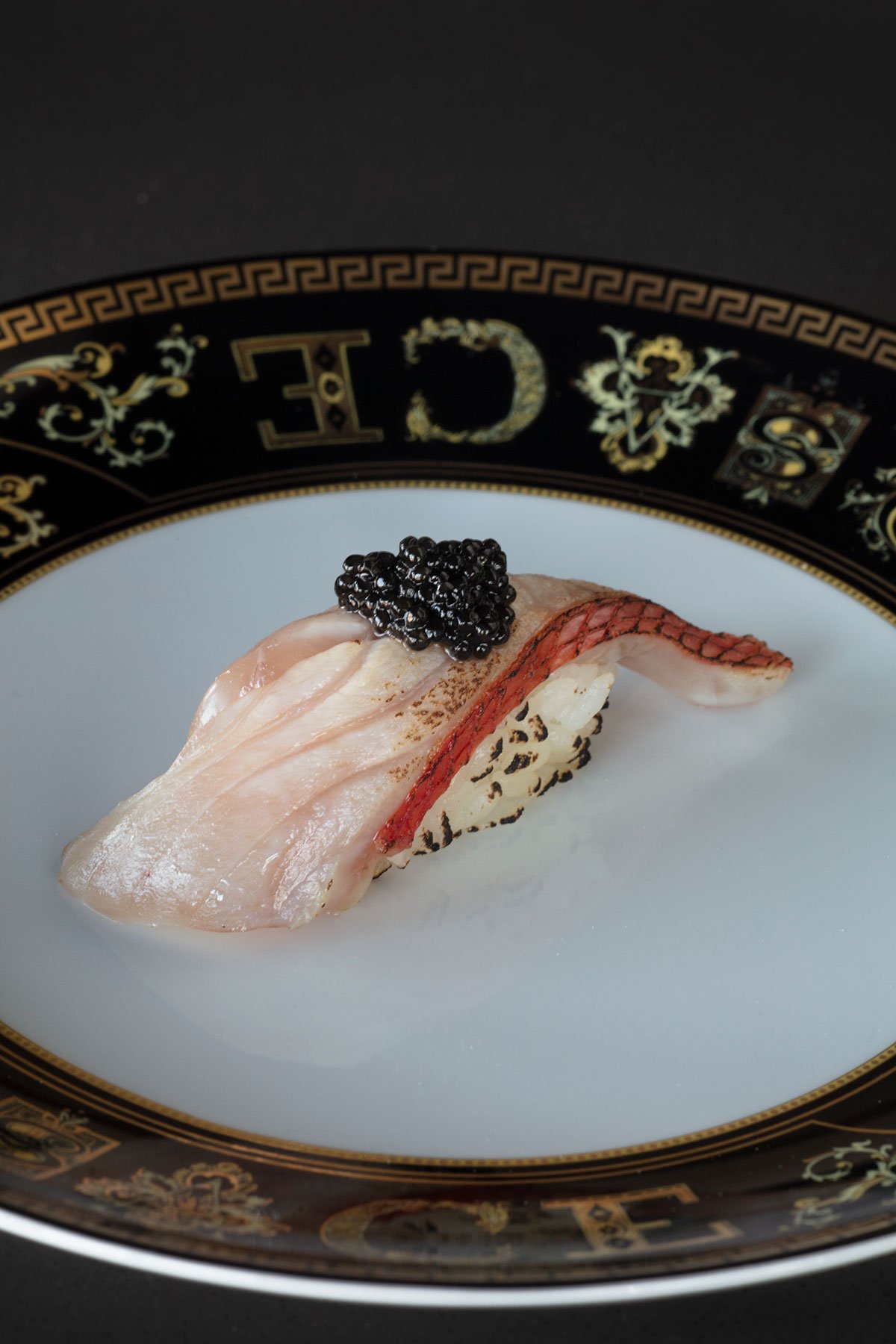
“What do you call a door that’s really cute?” The question pops up in the middle of a $130 omakase sushi dinner—posed to 12 diners at the sushi counter by the chef, Aung Lawalt, …
… who’s giggling at his own dad joke. “I’ll give you 10% off if you get the right answer.
A typical sushi meal at Omakase by Aung is anything but typical. The chef, first: Born in Myanmar and raised in Thailand, he arrived in the United States as a gregarious political science major intent on becoming a diplomat. But he fell in love with sushi when he landed a part-time job at Akiko’s, a Michelin Guide restaurant in San Francisco. His youth: Only 28 years old, Lawalt opened his sushi counter last summer because he loves the back-and-forth with diners as much as he loves sushi. He chose Kapahulu Avenue and not New York City, where he’d been working at a sushi bar in the East Village, because Hawai‘i’s pace seemed less frenetic, and because his brothers live here.
Then there’s the sushi. It’s mostly traditional, some pieces like akami of bluefin tuna hinting at the intensified flavors and sanmi, or acidity, of Edomae-style aging and curing techniques—but then it veers. A scallop is folded into crisp nori atop a pat of rice, its silky, cool sweetness a pleasant contrast with the warm, vinegared grains. A slice of A5 Miyazaki wagyu arrives lightly torched and sprinkled with truffle salt and lime zest. And uni, which crescendos across three appearances: first as a glistening garnish atop hirame nigiri, later in the 15 courses as exuberant golden heaps slathered and mixed into warm sushi rice topped with caviar, and finally, because Lawalt, shaking his head, can’t stop admiring them, as naked lobes laid simply on plates with nori that the chef hands out around the counter.
“I don’t want to follow other people. If I fail, I fail. I want to create my own stuff,” he says. “And I want a really interactive sushi bar. I want people to feel at home when they come to my restaurant.”
Which brings us back to the dad joke. No one guesses the correct answer, which makes Lawalt giggle harder. “Adorable!” the chef crows.
–Mari Taketa
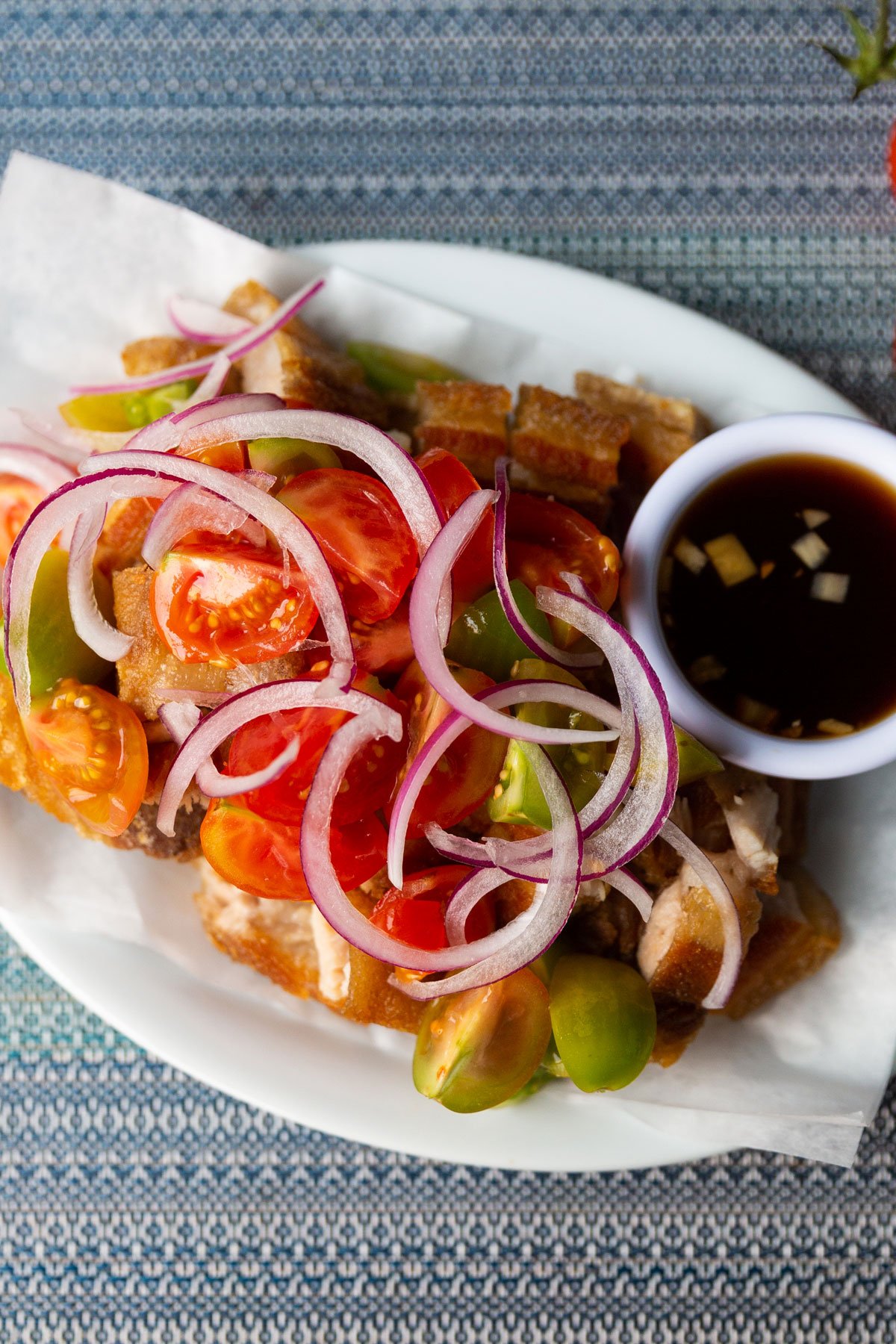
Sheldon Simeon is recycling. As in literally, hauling bottles and cans in his truck to the recycling center as we talk on the phone. But as we talk, I realize recycling is what Simeon does. Like with his …
… smash hit Tin Roof Maui, bringing touched-up plate lunches to a former okazuya space, or with his latest, Tiffany’s, taking over a Wailuku dive bar.
The building housing Tiffany’s has a deep history. In its most recent 20 years, it was one of Wailuku’s most beloved bars. From the 1950s to the ’70s, it was Wing Sing, a chop suey restaurant. And in years between, it was a hostess bar. Enter Simeon, with his own deep history, some of it overlapping with Tiffany’s. After finishing culinary school on Maui, he’d head there with friends, “trying to feel like an uncle, ordering too much food and watching uncles drinking Coors Light on ice,” he says. His order: “Steak bites, automatic. And crispy pork. It wasn’t good, but it’s something we always ordered. Just the Filipino in me, I guess. When I drink and eat, I gotta have fried pork belly.”
And so, when he took over the space in summer of 2022 and pared down the menu of more than 150 (yes, really) dishes, he kept the steak bites and the pork belly, improving the latter, of course, by letting more of the fat render and making it crispy. His Tiffany’s has a somewhat more manageable 50 dishes on the menu, and most are holdovers, just slightly tweaked. Like the salt and pepper shrimp, head-on, battered and fried and tossed with chile flakes and Thai basil. And the beef broccoli cake noodle, with copious oyster sauce gravy. My favorites, though, are his additions. He axed the surprisingly extensive sushi menu, but the hamachi sashimi, flooded with finadene, a Chamorro sauce that Simeon adapts with ponzu and plenty of onion and shiso, is all I need to be happy at Tiffany’s. The menu is still a work in progress as Simeon decides how much of the past to keep. But whether it’s a huge crispy pata that you need to pull apart with your hands or a simple clear saimin, Simeon continues to bring to the table the foods that locals like to eat.
–Martha Cheng
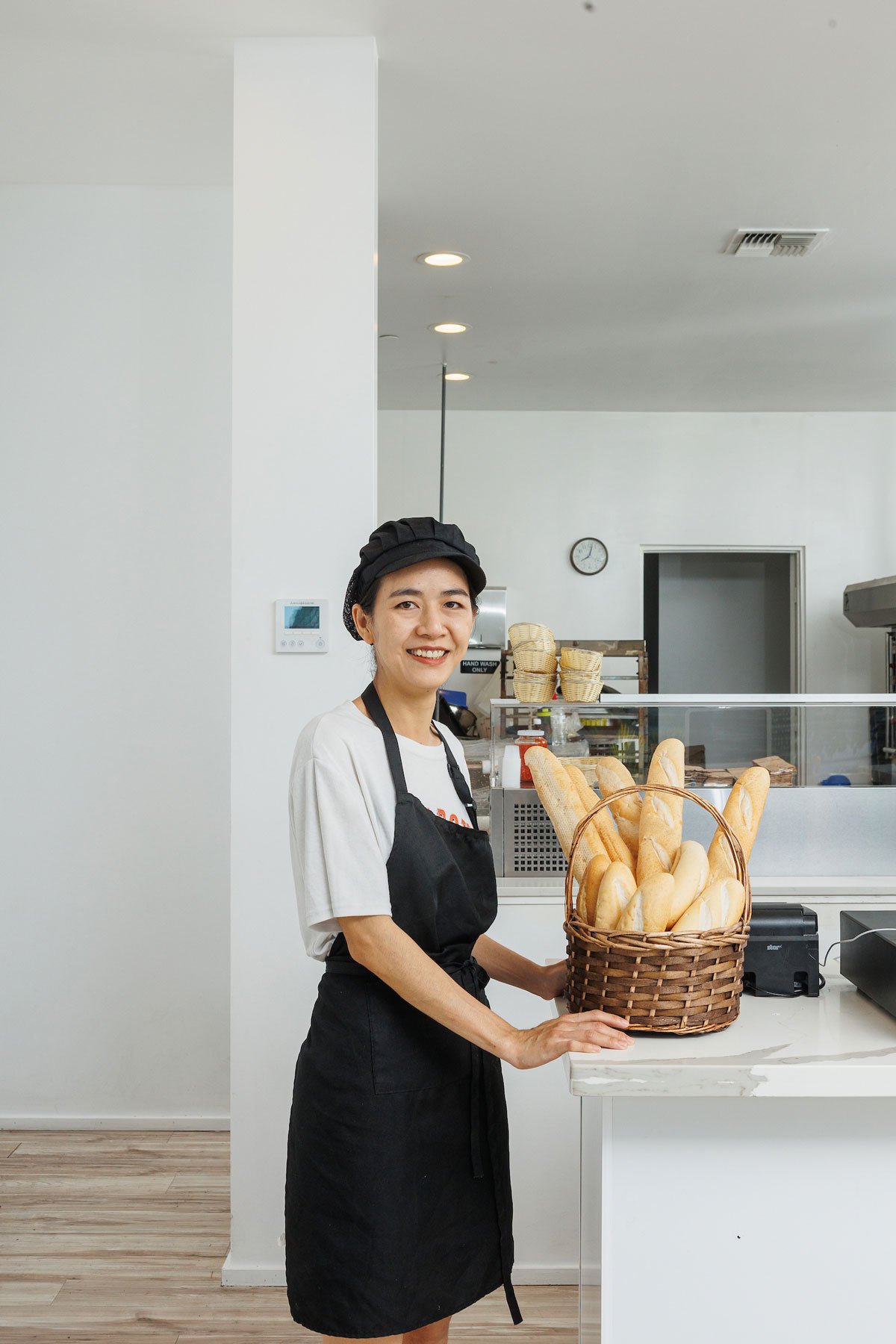
It’s rare to stumble upon a banh mi shop in Hawai‘i anymore. The once ubiquitous neighborhood Ba-Le shops are disappearing. And you’re even less likely to stumble across one like …
… the minimalist Le’s Banh Mi, where Chi Lam bakes her own bread. Vietnamese baguettes are in their own wonderful category. Lam knows this. When she moved from Ho Chi Minh City to Honolulu six years ago, she tried a lot of baguette recipes, “but none of them taste exactly like the [ones] I used to eat in Vietnam, so I decided to learn how to bake,” she says. She now creates her own version every morning, and the results are airy and chubby loaves with delicate crackly crusts.
And what she and her husband, Minh Tuan Le, do with them is just as lovely. The sandwiches are as restrained as the shop’s sleek white interior, which lets the details pop, like in the roast pork banh mi, with its delicate, soft center giving way to curly-cue green onions, seeded jalapeños, morsels of roast pork mixed with bits of fat and crackly skin. Even in the Saigon special, with all the fixings of cha lua steamed pork roll, ham, char siu, house-made pâté and mayo, cucumbers, jalapeño, pickles and cilantro, the bread still shines through. The vegetarian options include a lemongrass tofu as well as a mushroom banh mi. The entire menu consists of just four sandwiches and four drinks, including a coconut coffee—rich and strong, poured over a sweet and frothy coconut slush like a Vietnamese affogato. You won’t find plastic containers of spring rolls, rice cakes, buns and vermicelli. But with Lam and her husband’s attention to detail, you won’t miss what isn’t there.
–Martha Cheng/Thomas Obungen
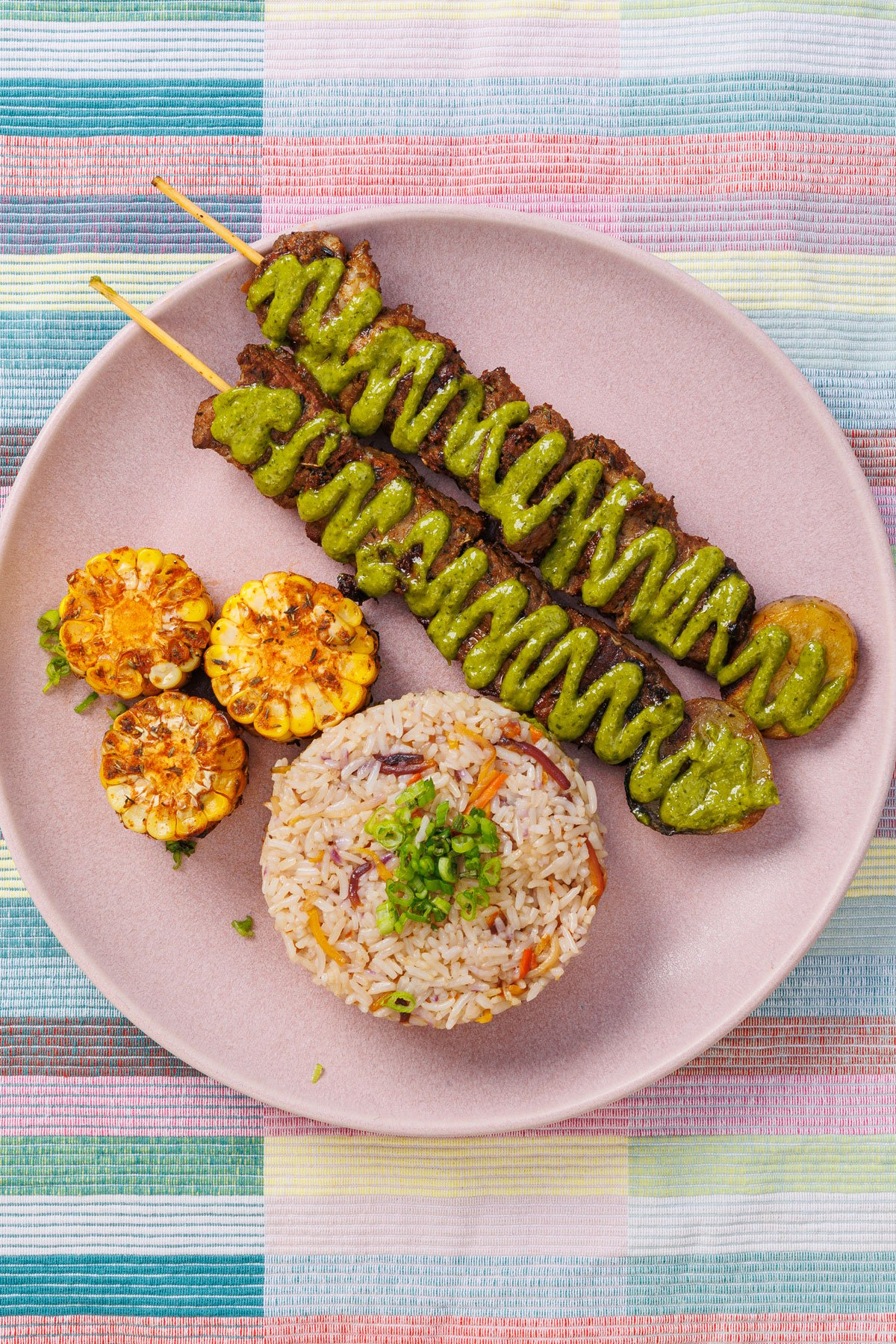
No one was serving anticuchos, juane or picarones in Honolulu until Miguel Gutierrez and Marlene Paucar bought a food truck. Out of a retired Handi-Van, they run El Gallo, making the food …
… they grew up with in Peru. First, the anticuchos: Traditionally, they’re grilled skewers of beef heart, but here, flank steak makes a fine and tender substitute. The meat is marinated overnight in ají panca, a Peruvian red pepper, and covered in a thick green ají huacatay, a creamy and bright condiment made of huacatay, or black mint, scallions, cilantro and jalapeños, just one of a few peppers that Gutierrez grows himself.
In Hawai‘i, most of what we know about Peruvian food revolves around ceviche or maybe Peruvian-style rotisserie chicken. But El Gallo serves up dishes that I’ve only read about, teeming with deeply satisfying sensibilities—a balance of full-bodied flavors and textures. Proof that threads of commonality circle the globe, Gutierrez takes juane, already like a Peruvian lau lau, and turns it even more Hawaiian, wrapping it in a taro leaf filled with teriyaki flank steak, turmeric- and cumin-scented rice, boiled eggs and olives, then steaming the package. It’s a twist on the main dish enjoyed in Peru during the Festival of San Juan, patron saint of the Amazon.
Gutierrez and Paucar met in Honolulu and discovered their common roots in the inland city of Ayacucho, Peru. They noticed that while there was some Peruvian coastal cuisine to be found in Hawai‘i, no one was cooking food from the inland. Weaving in as many local ingredients as possible, Gutierrez serves up the regional cuisine at Mother Waldron Park in Kaka‘ako and at markets across O‘ahu.
More wish-we-had-this-sooner items include the desserts, like the fried picarones, light and bouncy doughnuts made from butternut squash, their crispy exteriors drizzled with fig syrup while still hot. Gutierrez even makes his own potato starch for the mazamorra, a shiny, purple, corn-scented pudding dotted with fresh pineapple. “The goal is definitely to have a restaurant eventually,” he says. But in the meantime, “we just want to keep sharing Peruvian food with people. That’s the main thing.”
— Maria Burke
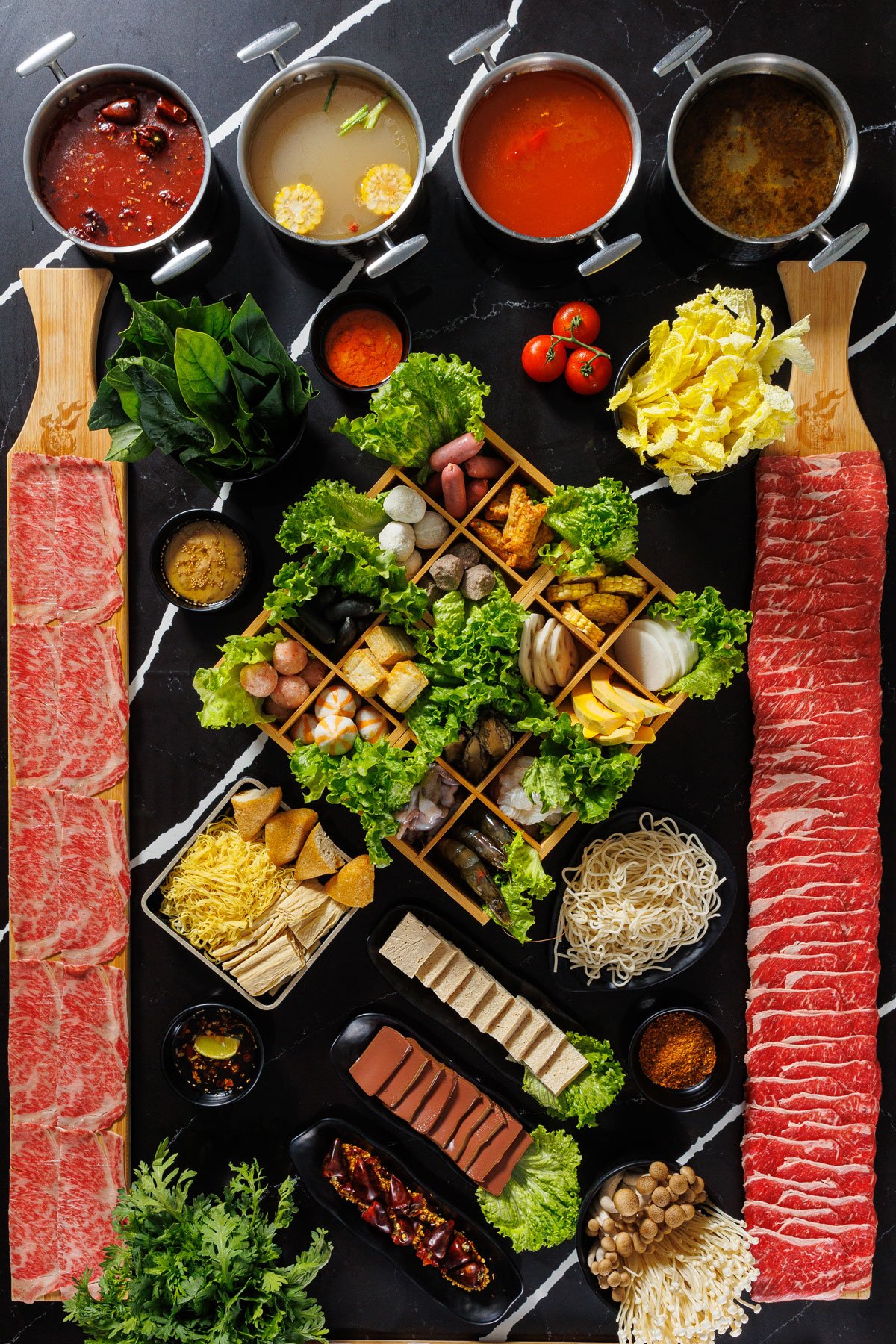
You pay a premium for eye candy at Honolulu Hotpot Hale, where meat is displayed on wooden paddles and other ingredients are arranged like artful mise en place. Forget those colored plates of …
… vegetable and fish balls wrapped in cling film. For once, hot pot feels upscale without the fussiness of fine dining. Protein options range from $19.99 for Kurobuta pork belly to a whopping $79.99 for 4 ounces of A5 wagyu rib-eye from Miyazaki, Japan. Sets of vegetables and bean curds suited for sharing, of which there are many, range from $9.99 to $12.99.
For each customer at the restaurant tucked inside the lobby of Pacific Guardian Tower on Kapi‘olani Boulevard, the premium DIY experience starts with an individual-sized pot and a butane burner. While most hot pot restaurants in town tend to lean Japanese, Hotpot Hale features the bold flavors and numbing spices of interior China. Your choice of soup, five beef-based broths listed without descriptions, includes a dish of dipping sauce or seasoning. Just go with your gut. I opt for the mild house broth with a sweet sesame dip. My friend goes for the recommended Chinese sauerkraut broth with cumin- and chile-flecked seasoning. Loaded with pickled mustard cabbage and with an herbal finish, it reminds her of her popo’s hot pot. Other choices include a spicy broth loaded with dried chiles and spices, plain beef and a rich tomato soup.
Next is the fun part: selecting ingredients for your bubbling vat. Thin strips of rolled marbled prime beef short rib, brisket and Angus chuck roll are served by the half- or full yard. Other meat selections are Kurobuta pork belly and New Zealand lamb—or you can splurge on a wagyu rib-eye. Remaining items are grouped in sets like the “B1,” which has beef tendon, book tripe, throat and luncheon meat; and the “S1” with Kaua‘i shrimp, fish fillets, abalone and squid. We skip the braised duck feet and beef stomach in favor of the mushroom, leafy veggie, and bean curd sets to go with our half-yard of short rib and plate of pork belly.
The Little Fried Pork, or xiao su rou, and a scallion pancake make for great snacks as you wait for the soup to boil. Dip the breaded pork in the chile spices and eat with the flaky pancake for maximum effect. Also, get your own scallion pancake—it’s too good to share.
–Thomas Obungen
Two were food counters at ‘Ohana Hale Marketplace, the third a weekly pop-up inside a sake brewery. Now Nana Ai Katsu, Atsushi and Hanale by Islander Sake have come into their own with their first brick-and-mortar restaurants—proving that notable eateries don’t always start out as restaurants, and sometimes they’re not even intentional.
By Mari Taketa
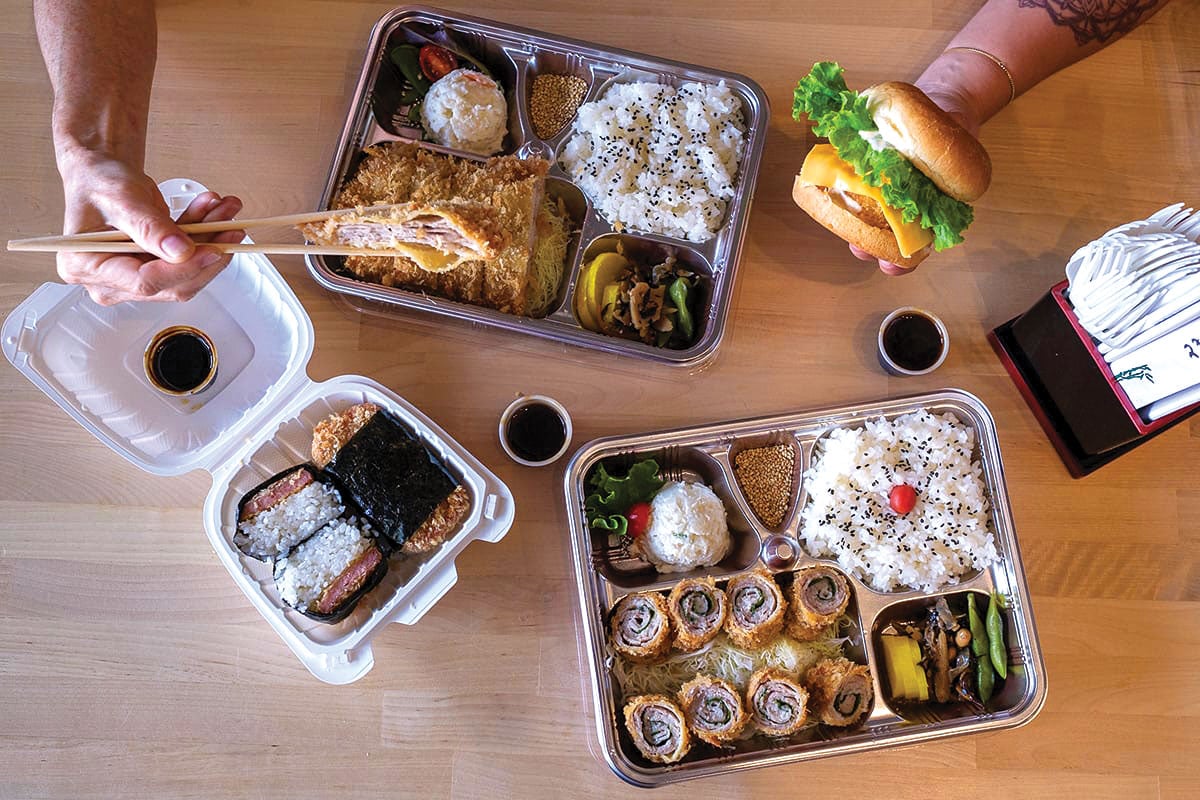
Festooned in paper lanterns and cartoonish blue and yellow banners, Nana Ai Katsu’s dining room floats in lightness and ebullience. This focus, forward- and upward-looking, makes it easy to forget that owners Michael and Lei-Anne Jones opened their first eatery after the pandemic forced the closure of their pain management and recovery shop in Waikīkī. Nana Ai, named for their daughter, drew immediate crowds to its ‘Ohana Hale Marketplace stall for juicy, crispy-soft tonkatsu made with seven layers of thinly sliced Berkshire pork. Spam katsu musubi joined a growing menu that fueled a move to Wai‘alae Avenue, Kaimukī’s mecca for eclectic upstarts. Last fall, Nana Ai transitioned from takeout-only and opened its festive space to dine-in customers, completing its transformation to a counter-service restaurant—and the only locally owned player in the top tier of Honolulu’s tonkatsu specialists.
$, 3585 Wai‘alae Ave., (808) 772-0146, @nana_ai_katsu
On the fringes of Chinatown, where foot traffic dies off with daylight, Hanale by Islander Sake proves again the adage that if you build it, they will come. The vision of a $120 omakase sushi bar in this part of the city was no less unlikely than Chiaki Takahashi’s earlier one—to build Hawai‘i’s first sake brewery in 30 years in industrial Kaka‘ako, which the Islander Sake brewer and partner achieved in March 2020. Then the pandemic made available Takahashi’s favorite sushi chef, Restaurant Suntory veteran Tetsuzo Yao. That was the path that led to Chinatown’s sole high-end sushi bar, where traditional nigiri like fresh saba and torched salmon belly mix with tofu salad and tsumami appetizers. Sake drinkers can pre-purchase bottles of Islander Sake—now flown in from Kohala on Hawai‘i Island, where the ever-visionary Takahashi has moved her brewery and is opening a second restaurant.
$$$$, 25 N. King St., (808) 517-8188, islandersake.com, @hanale_byislandersake
Where Yao never foresaw helming a sushi bar in Hawai‘i, Atsushi Kumagai forged ahead with his dream despite the unlikeliest of settings. Kumagai, who trained under chef Takeshi Kawasaki of Maru Sushi, took inspiration from ‘Ohana Hale Marketplace—where 10-by-10-foot spaces rented for $900 to $1,200 a month—to open a six-seat sushi counter. Fans ignored (or reveled in) the swap meet ambiance, which afforded exquisite omakase lunches priced around $100, and @sushi, the original name of the enterprise, expanded with table seating. Now at Waterfront Plaza in a proper restaurant of polished blond woods, Kumagai finally reigns in his own space at Atsushi. The omakase is $150 now, still a mix of mostly traditional nigiri and rolls with a nod to the modern and local, like inari bombs with diced salmon and other seafood. And it’s still offered at lunch only.
$$$$, 500 Ala Moana Blvd., (808) 358-4593, @atsushibv